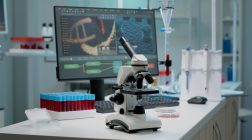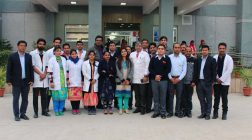India -Australia will have a bigger ties in Healthcare in in the field of medical bionics!
Robert K Shepherd is currently Director of the Bionics Institute, and Professor of Medical Bionics at the University of Melbourne, Australia. He is considered an expert in the field of cochlear implants, retinal prostheses, neural prostheses in general and deafness related changes within the auditory system.

Robert K Shepherd
Shepherd has an international reputation as an expert in the field of safety and efficacy of neural prostheses using both in vitro and in vivo research techniques. He was part of Graeme Clark’s original cochlear implant team and has 35 years of experience working in the field of medical bionics. More recently, Shepherd has been leading a groundbreaking programme by Bionic Vision and Hearing in Australia to restore vision that has been lost through retinal degenerative conditions such as retinitis pigmentosa and hearing in developmental and acquired anomalies of cochlea and hearing. This preclinical research programme has resulted in the design and manufacture of Australia’s first prototype Bionic Eye being implanted in three blind subjects in 2012.
He has numerous international collaborations and actively participates as a keynote speaker at various conferences.
Recently, the Australian Academy of Sciences in collaboration with the Australian Government’s Department of Industry, Innovation, Climate Change, Science, Research and Tertiary Education (DIICCSRTE) organized a speaker series in India with eminent Australian researchers to help raise awareness of Australian research and facilitate collaborative linkages with Indian researchers and Indian institutions.
Rob Shepherd, who visited India as a keynote speaker, in an exclusive interview with India Medical Times:
In which research areas, the Department of Medical Bionics is currently working?
We work in the area of Neurobionics. Our first technology was Cochlear implant. We work on implant devices that are used specifically to stimulate a record from damaged nerves. We played a key role in the development of Cochlear implant in 1970’s or 80’s that evolved into a company in Australia which is the largest Cochlear implant company in the world and we are using that technology to develop other bionic devices.
We are in the process of development of brain implants. The devices would be inserted into the brain to treat Parkinson’s disease, essential tremor, epilepsy, chronic pain, depression and obsessive compulsive disorder, as well as a device to relieve palliative care pain.
We have a small clinical trial for retinal prostheses. I am working with neurologists in USA who used to develop devices for deep brain stimulation for Parkinson’s disease and use it in other applications. So, it turns out that deep brain stimulation can be quite useful for patients with very severe psychiatric disorders, who don’t get any benefit from therapeutic drug. Currently, we are part of a clinical trial to evaluate deep brain stimulation for patients with severe depression.
We are also investigating the use of technology for application in late stage cancer patients where they are not getting any benefit from morphine or other drug based therapies. And finally, we are teaming up with the neurologists who work in the area of epilepsy. These neurobionic devices build on the cochlear implant system, which relies on a sophisticated, wearable computer system to control electrical signals, and uses implanted electrodes to stimulate brain tissue.
By tweaking the implanted part and putting electrodes on different parts of the brain to record the brain wave activity they are able to predict the onset of epileptic seizures and then warn the patients.
It is a difficult technology to develop but I think we can develop it. And then we believe we can use electrical stimulation to suppress that tsunami of neural activity in the brain to suppress the seizure but that will take time, may be at least ten years’ time. So, this is the whole area that we work upon.
What is the main purpose behind your visit to India?
The Australian government through the Australian Academy of Sciences has asked a number of well-known researchers in Australia to come to India and speak about their researches. The concept is to develop more links with researchers and clinicians in India so that Australia and India can collaborate more. I am here to deliver a lecture series in India’s top-tier research institutions and facilitate collaborations with Indian researchers and institutions. The purpose of the visit is to explore collaborative opportunities and give us exposure to evolutionary research to our Indian counterparts and work in the field of neurobionics more specifically bionic eye and cochlear implantation and related technologies.
The Australian government has funding opportunities for Indian researchers to come to Australia. Then there is a funding opportunity for developing collaborative research, finding opportunities for students to come to do their PhDs in Australia. I have three Indian PhD students under me and they are all spectacular.
What are the latest advancements in the area of medical bionics?
Well in retinal prostheses, we are developing a device that instead of stimulating the retina would stimulate the cortex. Some other nice devices, which are not under clinical trials yet, are in the stage of development. The epilepsy work is very exciting and then other groups are developing technology called brain computer interface. Then developing and using the same technology that brought sound to the deaf to create other implantable bionic devices. New electrodes — half a millimetre thick — are being designed to insert into the brain, detect abnormal brain activity and deliver instant treatment. The implant system relies on a sophisticated wearable-computer system to control electrical signals and use implanted electrodes to stimulate brain tissue. We’re in the process of developing and fine-tuning the devices and by proper clinicians and clinical trials.
Other devices are being used that implant a number of electrodes in the muscles of the arms to allow a person that doesn’t have any control over their arm movement to make some rudimentary movement like opening a cupboard. Such devices can be a huge advancement to provide independence of movements for patients.
What are the challenges in the area of medical bionics?
This work is truly multidisciplinary; so it requires clinicians, surgeons, physicians, engineers, and it requires scientists to work very close together. But when you get into a clinical trial, it also requires psychologists to make sure patients are very comfortable with the procedures and to monitor patients very carefully. Ethics committee is also needed to make sure the enthusiasm of scientists and engineers are kept within reasonable grounds. Getting all the experts to work as a team is a great effort.
What has been the response of those who have been benefitted by the technology?
Well, a cochlear implant has a great story. Before we started developing cochlear implants in 1970s, if you are profoundly deaf, there was no treatment at all. People used sign language.
Since cochlear implants came into scenario, it has at least given a sense of sound to a person who has a severe or profound hearing loss. In fact, in a quiet environment, a person with cochlear implant can have a normal conversation.
A cochlear implant does not cure deafness or hearing impairment but is a prosthetic substitute, which directly stimulates the cochlea. But the really exciting development has been for young children. For children, hearing is central to neurocognitive development. Sound deprivation early in life degrades the multiplicity of neural circuits that are responsible for information processing.
Up until 1990, we only implanted adults. Then we got approvals to implant young children and now children as young as 6 months of age get this device. Children learn how to make sense of the signals a cochlear implant gives to the brain. At first it sounds like a mechanical noise. But eventually the brain adapts and recognizes more normal speech sensations. So, it has brought a huge change in the lives of the people who are suffering from hearing impairments.
How can a country develop a research friendly environment?
My personal opinion is that significant amount of funding is needed if a country seriously wants a good research set-up. But that research needs to be targeted, so that a lot of outcomes of research could be commercialized within the country. A lot of investment is then needed in manufacturing those outcomes. The company called Cochlear Limited is a very good example of a success. But we also had many failures before Australia tried to commercialize with success. But if you get it right and you can commercialize, it brings back huge revenues into the country that creates some really good high quality jobs, more PhDs and more students going for higher education. The whole nation can benefit from it.
India has a huge population in comparison to Australia. But both countries have wide latitudes, so both countries have many similar clinical issues. We can greatly benefit by constructive researches.
How expensive bionic devices can be commercialized in a country like India?
Bionic devices indeed are expensive. But I feel after knowing the benefits of the technology, more people might use it and it can thus become cheaper. Of course, market for devices would slowly develop once they become commercially viable like in the case of pacemakers. I can say, there is a great opportunity for manufacturers in India.
What is on the cards now?
Our next big challenge is to commercialize retinal prostheses — to get all regulatory approvals and get it manufactured by a company for use in Australia and for use in other countries.
Your message?
Together clinicians, scientists, researchers and engineers from both countries have a great opportunity to work in the field of medical bionics. We can together develop good research groups as it is a multidisciplinary field and if we work in a group, we can go really far.











